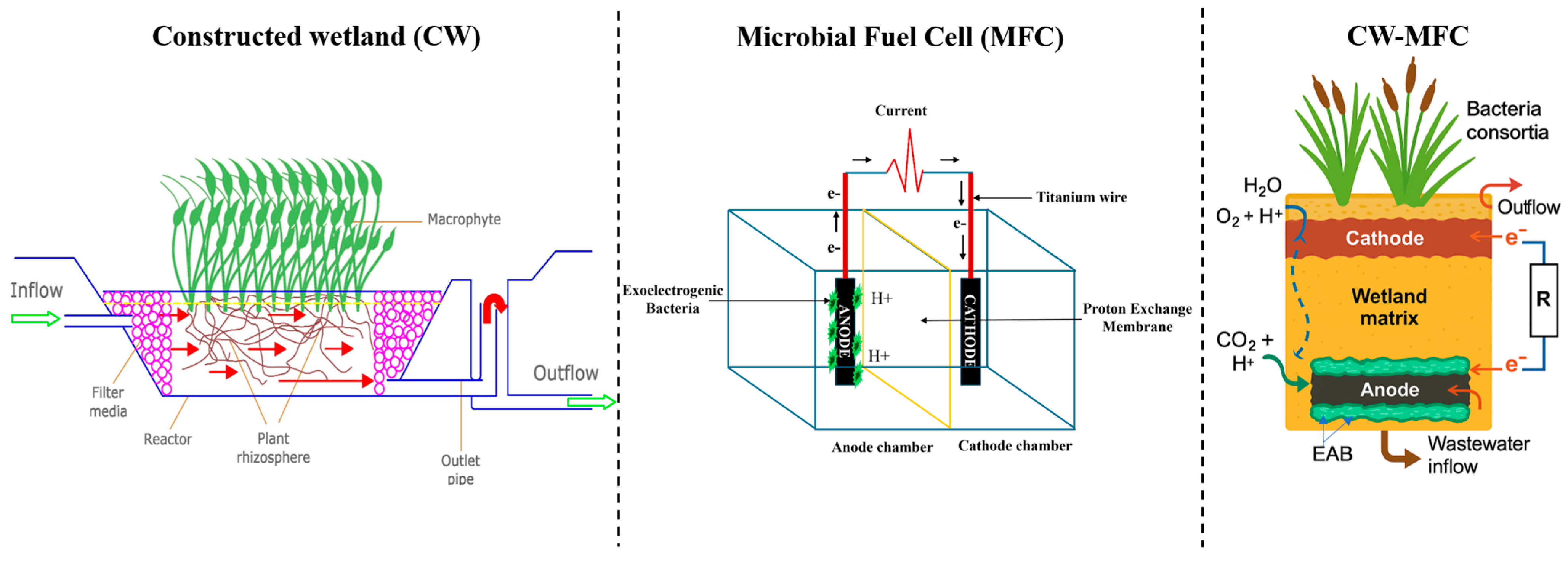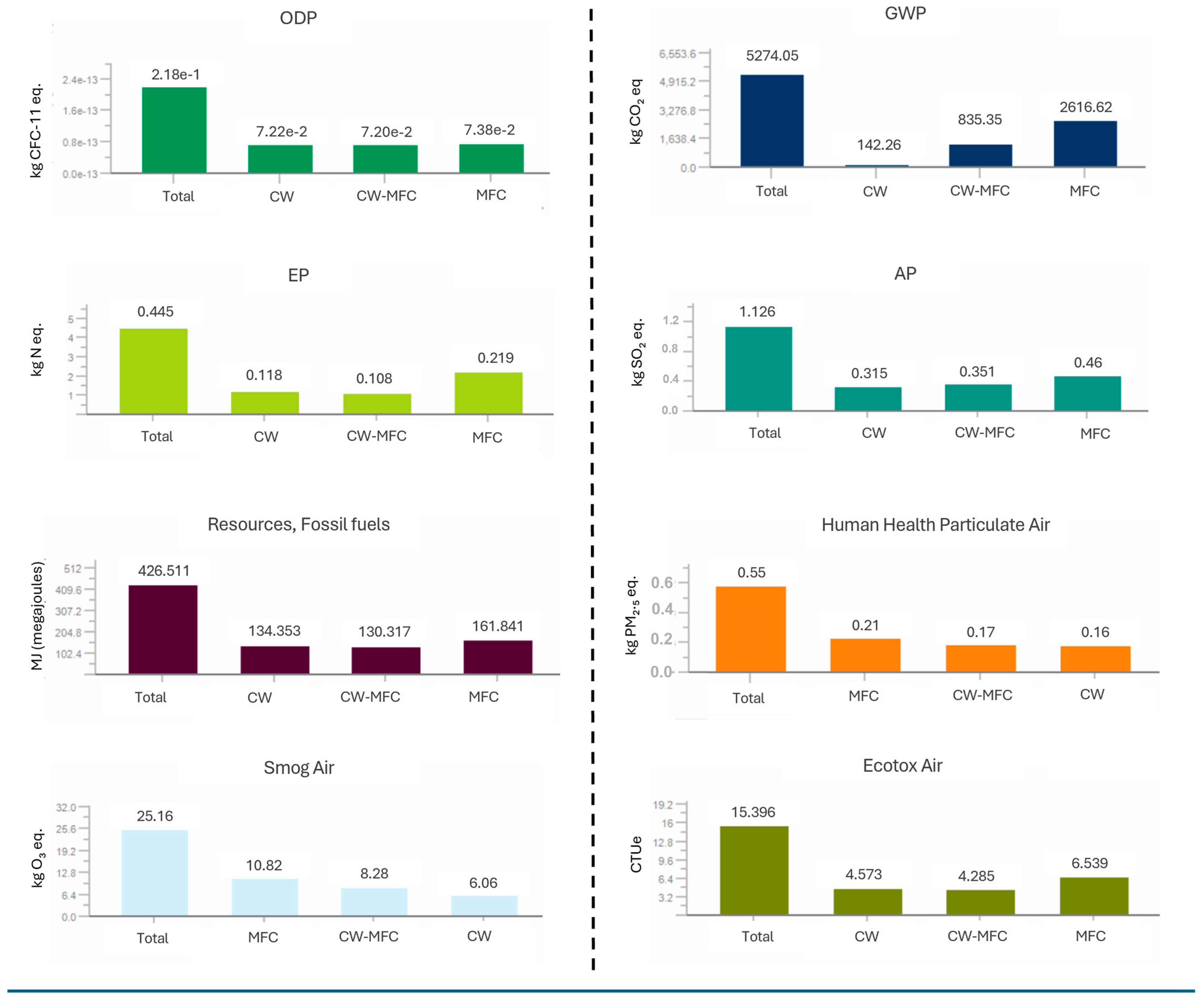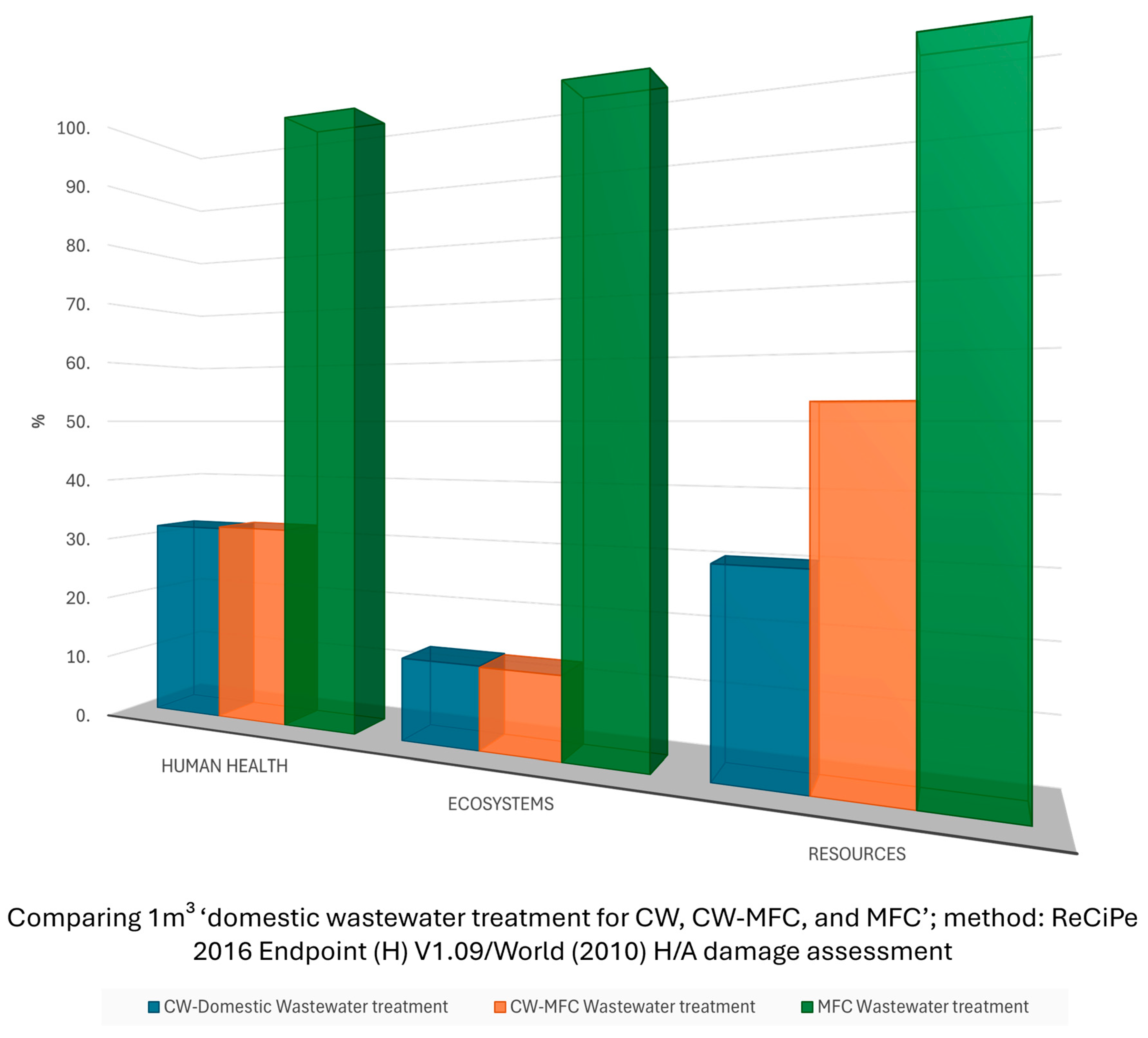Comparative Life Cycle and Techno-Economic Assessment of Constructed Wetland, Microbial Fuel Cell, and Their Integration for Wastewater Treatment
Abstract
1. Introduction
2. Materials and Methods
2.1. Goal of the LCA
2.2. System Description
2.3. System Boundary for LCA
2.4. Inventory Data Collection, Classification, and Characterization
2.5. Techno-Economic Analysis
3. Results and Discussion
3.1. Impact Assessment
3.2. Damage Assessment
3.3. Economic Analysis
4. Conclusions
Supplementary Materials
Author Contributions
Funding
Data Availability Statement
Acknowledgments
Conflicts of Interest
Abbreviations
| MFC | Microbial fuel cell |
| CW | Constructed wetland |
| CW–MFC | Constructed wetland–microbial fuel cell |
| TEA | Techno-economic analysis |
| LCA | Life Cycle Analysis |
| SDGs | Sustainable Development Goals |
| MCDA | Multi-criteria Decision Analysis |
| GHG | Greenhouse Gas |
| CAS | Conventional Activated Sludge |
| IPCC | Intergovernmental Panel on Climate Change |
| SRI | Slow Rate Infiltration |
| ISO | International Standards Organization |
| BAT | Best-available technology |
| CEM | Cation-Exchange Membrane |
| COD | Chemical Oxidation Demand |
| TN | Total Nitrogen |
| NO3 | Nitrate |
| TP | Total Phosphorus |
| VOCs | Volatile Organic Compounds |
| EP | Eutrophication potential |
| GWPs | Global warming potentials |
| ODP | Ozone Depletion Potential |
| AP | Acidification Potential |
| O&M | Operation and Maintenance |
References
- Odinga, C.A.; Swalaha, F.M.; Otieno, F.A.O.; Ranjith, K.R.; Bux, F. Investigating the efficiency of constructed wetlands in the removal of heavy metals and enteric pathogens from wastewater. Environ. Technol. Rev. 2013, 2, 37–41. [Google Scholar] [CrossRef]
- Matesun, J.; Petrik, L.; Musvoto, E.; Ayinde, W.; Ikumi, D. Limitations of wastewater treatment plants in removing trace anthropogenic biomarkers and future directions: A review. Ecotoxicol. Environ. Saf. 2024, 281, 116610. [Google Scholar] [CrossRef] [PubMed]
- Machado, A.P.; Urbano, L.; Brito, A.G.; Janknecht, P.; Salas, J.J.; Nogueira, R. Life cycle assessment of wastewater treatment options for small and decentralized communities. Water Sci. Technol. 2007, 56, 15–22. [Google Scholar] [CrossRef] [PubMed]
- United Nations. Report of the Secretary-General on SDG Progress 2019: Special Edition; United Nations Publ.: New York, NY, USA, 2019; pp. 1–64. Available online: https://sustainabledevelopment.un.org/content/documents/24978Report_of_the_SG_on_SDG_Progress_2019.pdf (accessed on 23 February 2025).
- Obaideen, K.; Shehata, N.; Sayed, E.T.; Abdelkareem, M.A.; Mahmoud, M.S.; Olabi, A.G. The role of wastewater treatment in achieving sustainable development goals (SDGs) and sustainability guideline. Energy Nexus 2022, 7, 100112. [Google Scholar] [CrossRef]
- Nishat, A.; Yusuf, M.; Qadir, A.; Ezaier, Y.; Vambol, V.; Khan, M.I.; Moussa, S.B.; Kamyab, H.; Sehgal, S.S.; Prakash, C.; et al. Wastewater treatment: A short assessment on available techniques. Alex. Eng. J. 2023, 76, 505–516. [Google Scholar] [CrossRef]
- Sánchez-García, E.; Martínez-Falcó, J.; Marco-Lajara, B.; Manresa-Marhuenda, E. Revolutionizing the circular economy through new technologies: A new era of sustainable progress. Environ. Technol. Innov. 2024, 33, 103509. [Google Scholar] [CrossRef]
- Lopsik, K. Life cycle assessment of small-scale constructed wetland and extended aeration activated sludge wastewater treatment system. Int. J. Environ. Sci. Technol. 2013, 10, 1295–1308. [Google Scholar] [CrossRef]
- Dixon, A.; Simon, M.; Burkitt, T. Assessing the environmental impact of two options for small-scale wastewater treatment: Comparing a reedbed and an aerated biological filter using a life cycle approach. Ecol. Eng. 2003, 20, 297–308. [Google Scholar] [CrossRef]
- Corominas, L.; Foley, J.; Guest, J.S.; Hospido, A.; Larsen, H.F.; Morera, S.; Shaw, A. Life cycle assessment applied to wastewater treatment: State of the art. Water Res. 2013, 47, 5480–5492. [Google Scholar] [CrossRef]
- Miwornunyuie, N.; Mao, G.; Benani, N.; Dankwa, J.; Hunter, J. Investigating the research and development status and trends of constructed wetlands: A bibliometric and patent analysis. J. Water Process Eng. 2024, 63, 105430. [Google Scholar] [CrossRef]
- Liu, M.; Zhu, G.; Tian, Y. The historical evolution and research trends of life cycle assessment. Green Carbon 2024, 2, 425–437. [Google Scholar] [CrossRef]
- Finkbeiner, M.; Inaba, A.; Tan, R.; Christiansen, K.; Klüppel, H.-J. The New International Standards for Life Cycle Assessment: ISO 14040 and ISO 14044. Int. J. Life Cycle Assess. 2006, 11, 80–85. [Google Scholar] [CrossRef]
- ISO 14040:2006; Environmental Management—Life Cycle Assessment—Principles and Framework. ISO: Geneva, Switzerland, 2004. Available online: https://www.iso.org/standard/23151.html (accessed on 18 March 2025).
- Weiss, P.; Eveborn, D.; Kärrman, E.; Gustafsson, J.P. Environmental systems analysis of four on-site wastewater treatment options. Resour. Conserv. Recycl. 2008, 52, 1153–1161. [Google Scholar] [CrossRef]
- De Feo, G.; Ferrara, C. A procedure for evaluating the most environmentally sound alternative between two on-site small-scale wastewater treatment systems. J. Clean. Prod. 2017, 164, 124–136. [Google Scholar] [CrossRef]
- Yildirim, M.; Topkaya, B. Assessing environmental impacts of wastewater treatment alternatives for small-scale communities. Clean-Soil Air Water 2012, 40, 171–178. [Google Scholar] [CrossRef]
- Nogueira, R.; Brito, A.G.; Machado, A.P.; Janknecht, P.; Salas, J.J.; Vera, L.; Martel, G. Economic and environmental assessment of small and decentralized wastewater treatment systems. Desalin. Water Treat. 2009, 4, 16–21. [Google Scholar] [CrossRef]
- Garfí, M.; Flores, L.; Ferrer, I. Life Cycle Assessment of wastewater treatment systems for small communities: Activated sludge, constructed wetlands and high rate algal ponds. J. Clean. Prod. 2017, 161, 211–219. [Google Scholar] [CrossRef]
- Flores, L.; García, J.; Pena, R.; Garfí, M. Carbon footprint of constructed wetlands for winery wastewater treatment. Ecol. Eng. 2020, 156, 105959. [Google Scholar] [CrossRef]
- Corbella, C.; Puigagut, J.; Garfí, M. Life cycle assessment of constructed wetland systems for wastewater treatment coupled with microbial fuel cells. Sci. Total Environ. 2017, 584–585, 355–362. [Google Scholar] [CrossRef]
- Fang, Y.K.; Wang, H.C.; Fang, P.H.; Liang, B.; Zheng, K.; Sun, Q.; Li, X.Q.; Zeng, R.; Wang, A.J. Life cycle assessment of integrated bioelectrochemical-constructed wetland system: Environmental sustainability and economic feasibility evaluation. Resour. Conserv. Recycl. 2023, 189, 106740. [Google Scholar] [CrossRef]
- Jacobs, D.G.; Kachienga, L.O.; Rikhotso, M.C.; Abia, A.L.K.; Traoré, A.N.; Potgieter, N. Assessing the current situation of constructed wetland-microbial fuel cells as an alternative power generation and wastewater treatment in developing countries. Front. Energy Res. 2024, 12, 1448730. [Google Scholar] [CrossRef]
- Arliyani, I.; Noori, M.T.; Ammarullah, M.I.; Tangahu, B.V.; Mangkoedihardjo, S.; Min, B. Constructed wetlands combined with microbial fuel cells (CW-MFCs) as a sustainable technology for leachate treatment and power generation. RSC Adv. 2024, 14, 32073–32100. [Google Scholar] [CrossRef]
- Santoro, C.; Arbizzani, C.; Erable, B.; Ieropoulos, I. Microbial fuel cells: From fundamentals to applications. A review. J. Power Sources 2017, 356, 225–244. [Google Scholar] [CrossRef]
- Logan, B.E.; Rabaey, K. Conversion of Wastes into Bioelectricity and Chemicals by Using Microbial Electrochemical Technologies. Science (80-) 2012, 337, 686–690. [Google Scholar] [CrossRef]
- Xu, C.; Gong, B.; Zhao, S.; Sun, X.M.; Wang, S.G.; Song, C. Cu(ii) inhibited the transport of tetracycline in porous media: Role of complexation, Environ. Sci. Process. Impacts 2024, 26, 1417–1428. [Google Scholar] [CrossRef]
- Ge, X.; Cao, X.; Song, X.; Wang, Y.; Si, Z.; Zhao, Y.; Wang, W.; Tesfahunegn, A.A. Bioenergy generation and simultaneous nitrate and phosphorus removal in a pyrite-based constructed wetland-microbial fuel cell. Bioresour. Technol. 2020, 296, 122350. [Google Scholar] [CrossRef]
- Yang, H.; Chen, J.; Yu, L.; Li, W.; Huang, X.; Qin, Q.; Zhu, S. Performance optimization and microbial community evaluation for domestic wastewater treatment in a constructed wetland-microbial fuel cell. Environ. Res. 2022, 212, 113249. [Google Scholar] [CrossRef]
- Wu, Y.; Han, R.; Yang, X.; Zhang, Y.; Zhang, R. Long-term performance of an integrated constructed wetland for advanced treatment of mixed wastewater. Ecol. Eng. 2017, 99, 91–98. [Google Scholar] [CrossRef]
- Vymazal, J. Constructed Wetlands for Wastewater Treatment: Five Decades of Experience. Environ. Sci. Technol. 2011, 1, 61–69. [Google Scholar] [CrossRef]
- Vassalle, L.; Ferrer, I.; Passos, F.; Filho, C.R.M.; Garfí, M. Nature-based solutions for wastewater treatment and bioenergy recovery: A comparative Life Cycle Assessment. Sci. Total Environ. 2023, 880, 163291. [Google Scholar] [CrossRef]
- Tamta, P.; Rani, N.; Mittal, Y.; Yadav, A.K. Evaluating the Potential of Multi-Anodes in Constructed Wetlands Coupled with Microbial Fuel Cells for Treating Organic Loads. Energies 2023, 16, 784. [Google Scholar] [CrossRef]
- Colares, G.S.; Dell’Osbel, N.; Paranhos, G.; Cerentini, P.; Oliveira, G.A.; Silveira, E.; Rodrigues, L.R.; Soares, J.; Lutterbeck, C.A.; Rodriguez, A.L.; et al. Hybrid constructed wetlands integrated with microbial fuel cells and reactive bed filter for wastewater treatment and bioelectricity generation. Environ. Sci. Pollut. Res. 2022, 29, 22223–22236. [Google Scholar] [CrossRef]
- Wang, X.; Tian, Y.; Liu, H.; Zhao, X.; Peng, S. Optimizing the performance of organics and nutrient removal in constructed wetland–microbial fuel cell systems. Sci. Total Environ. 2019, 653, 860–871. [Google Scholar] [CrossRef]
- Zhang, Y.; Liu, F.; Lin, Y.; Sun, L.; Guo, X.; Yang, S.; He, J. Enhanced Swine Wastewater Treatment by Constructed Wetland—Microbial Fuel Cell Systems. Water 2022, 14, 3930. [Google Scholar] [CrossRef]
- Miwornunyuie, N.; Ugochukwu, G.; Hunter, J. Evolutionary trends and development of constructed wetland coupled microbial fuel cell: A decade of development. J. Environ. Manag. 2025, 373, 123574. [Google Scholar] [CrossRef]
- Wang, J.; Ren, K.; Zhu, Y.; Huang, J.; Liu, S. A Review of Recent Advances in Microbial Fuel Cells: Preparation, Operation, and Application. BioTech 2022, 11, 44. [Google Scholar] [CrossRef]
- Yu, X.; Sekhari, A.; Nongaillard, A.; Bouras, A.; Yu, S.; Yang, Q. A LCIA Model Considering Pollution Transfer Phenomena. In Proceedings of the Product Lifecycle Management for Society (PLM 2013), Berlin, Heidelberg, 8–10 July 2013; pp. 365–374. [Google Scholar] [CrossRef]






| Reference | Technologies | Functional Unit | LCA Tool | System Boundary |
|---|---|---|---|---|
| Dixon et al. [9] | Reedbed (CW) and aerated biological filter system | (p.e) | SimaPro software | Construction and operation of the systems but not end-of-life |
| Machado et al. [3] | CW, slow rate infiltration (SRI), and CAS | 120 p.e 120 p.e 500 p.e | CML 2 Baseline 2000 | Construction, operation and maintenance, dismantling, and final disposal |
| Lopsik [8] | CW and extended aeration-activated sludge system (CAS) | 64 p.e 1020 p.e | SimaPro software Impact 2002+ and ReCiPe assessment methods | Construction and operation phases |
| De Feo and Ferrar [16] | CW and CAS | 15 p.e | IPCC 2007, Ecological Footprints, and ReCiPe 2008 | Construction, operation and maintenance, dismantling, and final disposal |
| Yildirim and Topkaya [17] | CW, CAS, and vegetated land treatment | 100 p.e 806 p.e 100 p.e | SimaPro 7.1 software | Construction and operation phases |
| Nogueira et al. [18] | CW, SRI, and CAS | 120 p.e 120 p.e 500 p.e | SimaPro7 software | Construction, operation and maintenance, dismantling, and final disposal |
| Garfi et al. [19] | CW, CAS, and high-rate algal ponds | 1500 p.e 1500 p.e 1500 p.e | SimaPro8 employing the ReCiPe midpoint method | Construction and operation |
| Corbella et al. [21] | CW, CW–MFC with gravel-based anode, and CW–MFC with graphite anode | 1500 p.e 1500 p.e 1500 p.e 1 m3 | Software SimaPro® 8, using the CML-IA baseline method | Construction and operation |
| Flores et al. [20] | CW third-party management and CAS system | 1 m3 | SimaPro® 8 software and IPCC Global Warming Potential method (IPCC GWP 100 years) | Construction and operation |
| Present study | CW, MFC, and CW–MFC | 1 m3 | GaBi + TRACI 2.1 ReCiPe 2016 Endpoint | Construction and operation |
| Treatment Technology | Phase | Material | Quantity |
|---|---|---|---|
| Constructed Wetland (CW) | Construction | Polypropylene container | 1.77 kg |
| Gravel | 4.54 kg | ||
| Activated carbon | 4.54 kg | ||
| Zeolite | 4.54 kg | ||
| Silicon tubes | (192 × 0.18 × 0.04) in; 0.132 kg | ||
| Drilling appliance | 0.018 kWh | ||
| Transportation | 5.7 miles | ||
| Operation | COD | 268 mg/L | |
| TN | 13.79 mg/L | ||
| NO3 | 14.65 mg/L | ||
| TP | 9.2 mg/L | ||
| CH4 | 65 kg/yr | ||
| CO2 | 55 kg/yr | ||
| Microbial Fuel Cell (MFC) | Construction | Acrylic reactor | 2.7 kg |
| Graphite plate electrodes | 0.0737 kg | ||
| Resistance box | 1 | ||
| Titanium wire | 0.0277 kg | ||
| Membrane | 2.01 kg | ||
| Silicon tubes | (192 × 0.18 × 0.04) in; 0.132 kg | ||
| Graphite felt | 0.027 kg/(3 × 200 × 300) mm | ||
| Graphite plate electrodes | 0.0737 kg | ||
| Drilling appliance | 0.018 kWh | ||
| Transportation | 5.7 miles | ||
| Operation | Pumps | 36 kWh | |
| Energy-produced | 72.2 mW/m2 | ||
| COD | 417 mg/L | ||
| TN | 317 mg/L | ||
| NO3 | 13.37 mg/L | ||
| TP | 19.67 mg/L | ||
| CH4 | 95 kg/yr | ||
| CO2 | 55 kg/yr | ||
| Polypropylene container | 1.77 kg (2 gallons) | ||
| Constructed Wetland–Microbial Fuel Cell (CW–MFC) | Construction | Graphite plate electrodes | 1.8 kg |
| Resistance box | 1 | ||
| Titanium wire | 0.0277 kg | ||
| Silicon tubes | (192 × 0.18 × 0.04) in; 0.132 kg | ||
| Gravel | 4.54 kg | ||
| Activated carbon | 4.54 kg | ||
| Zeolite | 4.54 kg | ||
| Drilling appliance | 0.018 kWh | ||
| Transportation | 5.7 miles | ||
| Operation | Pumps | 36 kWh | |
| Energy-produced | 22.24 mW/m2 | ||
| COD | 259 mg/L | ||
| TN | 7 mg/L | ||
| NO3 | 10.6 mg/L | ||
| TP | 7.9 mg/L | ||
| CH4 | 72 kg/yr | ||
| CO2 | 24 kg/yr |
| Technology | Construction Cost (USD/m3) | Operation and Maintenance Cost (USD/m3) | Total Cost (USD/m3) |
|---|---|---|---|
| CW | USD 328.33 | USD 299.00 | USD 627.33 |
| MFC | USD 614.90 | USD 274.00 | USD 888.90 |
| CW–MFC | USD 439.33 | USD 279.00 | USD 718.33 |
Disclaimer/Publisher’s Note: The statements, opinions and data contained in all publications are solely those of the individual author(s) and contributor(s) and not of MDPI and/or the editor(s). MDPI and/or the editor(s) disclaim responsibility for any injury to people or property resulting from any ideas, methods, instructions or products referred to in the content. |
© 2025 by the authors. Licensee MDPI, Basel, Switzerland. This article is an open access article distributed under the terms and conditions of the Creative Commons Attribution (CC BY) license (https://creativecommons.org/licenses/by/4.0/).
Share and Cite
Miwornunyuie, N.; Alamu, S.O.; Mao, G.; Benani, N.; Hunter, J.; Oguntimein, G. Comparative Life Cycle and Techno-Economic Assessment of Constructed Wetland, Microbial Fuel Cell, and Their Integration for Wastewater Treatment. Clean Technol. 2025, 7, 57. https://doi.org/10.3390/cleantechnol7030057
Miwornunyuie N, Alamu SO, Mao G, Benani N, Hunter J, Oguntimein G. Comparative Life Cycle and Techno-Economic Assessment of Constructed Wetland, Microbial Fuel Cell, and Their Integration for Wastewater Treatment. Clean Technologies. 2025; 7(3):57. https://doi.org/10.3390/cleantechnol7030057
Chicago/Turabian StyleMiwornunyuie, Nicholas, Samuel O. Alamu, Guozhu Mao, Nihed Benani, James Hunter, and Gbekeloluwa Oguntimein. 2025. "Comparative Life Cycle and Techno-Economic Assessment of Constructed Wetland, Microbial Fuel Cell, and Their Integration for Wastewater Treatment" Clean Technologies 7, no. 3: 57. https://doi.org/10.3390/cleantechnol7030057
APA StyleMiwornunyuie, N., Alamu, S. O., Mao, G., Benani, N., Hunter, J., & Oguntimein, G. (2025). Comparative Life Cycle and Techno-Economic Assessment of Constructed Wetland, Microbial Fuel Cell, and Their Integration for Wastewater Treatment. Clean Technologies, 7(3), 57. https://doi.org/10.3390/cleantechnol7030057






